
This is a translation done by my friend Dr. Türker Savaş to Turkish and by me to English. It is not changed in any way to have a fluent English, to prevent any loss of contend and is in a rough text format. I have always found most pigeon books to be misleading and sometimes just full of wrong information when it comes to the breeds of Eastern World. So, I wanted to open this book (since it is considered to be one of the most through of them all) to critique. As I receive educated comments on each section, they will be posted. Since I am most interested in Turkish breeds and how they are represented, I hope to continue to do this on all books written on our breeds. Purpose is to ensure that the future writers stick to the facts and write about things they know firsthand, not what they hear or create in their own minds to make up for lack of knowledge.
GRUPPE IX TUMMLERTAUBEN:
In recent years we have had some tumbler and roller breeds from Turkey come in (to Germany). We can separate these by their talents as highfliers, divers, tumblers, and rollers. It is not possible to separate some of these breeds based on their looks, especially the divers
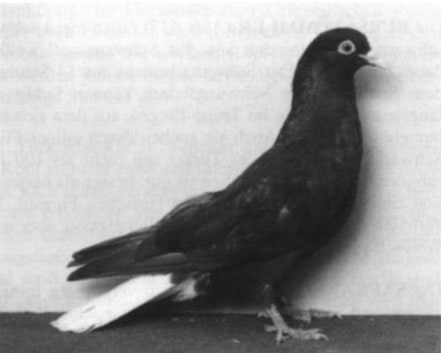
Döneks:They are mainly raised in Turkey. These strong built birds can be seen in almost all colors but, mostly in pied and baldhead patterns. Tail is in general larger than normal and comes with more than 12 feathers. Döneks gain altitude quickly and never fly in a group
Double Crested Turkish Tumbler:Even Darwin had named this bird as the "Smyrnian (The city of Izmir in the Aegean coast of southern Turkey) Double Crested Tumbler" They come in varieties of clean legged, groused, and muffed legs. They are relatives to Asian Clap Tumbler
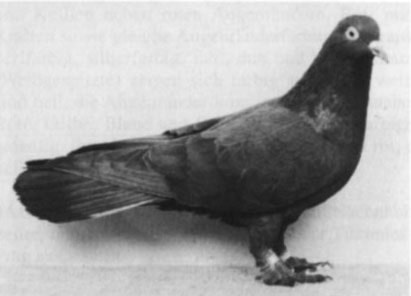
Takla "Clap Tumblers:They are built very similar to other Asiatic clap tumblers. They are a mid-size breed with a mid-size beak, light eye coloration and muffed or semi-clean legs.
Urfa & Filibe Clap Tumblers:Medium height and muffed birds. Crests and rose absent in both breeds. These breeds have almost no differences from each other.
Konya Clap Tumblers:Small beaked and muffed. The rest of the characteristics are same as the other breeds in this group.
Taklambaç:There is definitely some "Owl" blood in this breed. The beak length is either small or medium. They have tight feathering and in spite of their relation to Owls they do not have chest rose. All colors are present including black & white, black tailed and pied ones. They fly in mid heights and tumble less compared to other breeds.
Bango Flight Pigeons:Being relative to the previous breed
Kelebek:It has been seen in Germany in last few years. An Interesting breed. The name Kelebek comes from the style of this breed's flight.
Mülakat Roller:It is common to see white tails in this mostly blue breed. It is said that they were frequently mixed with wild rock pigeons to increase their flight skills. Roughly build, clean legged and no head ornaments but it is said to be an exceptional roller.
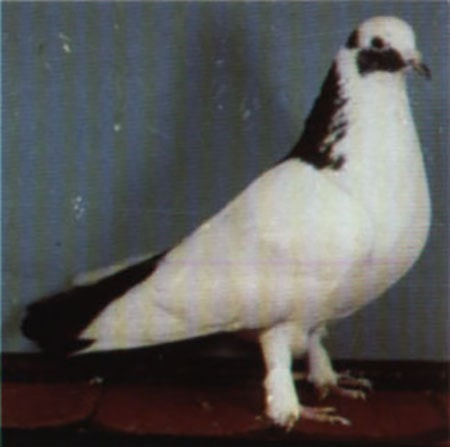

Çakal Roller:They are very similar to mülakat as far as their looks. However, they are mainly red color with white tail and flights markings.

Bursa Tumbler:They are mostly found in black, dark blue and blue bar colors. Tail must be white.
Safkan Roller:A medium size bird. It is thought that this breed is from a cross of Smyrna and Bulgarian rollers. Their body shape is very similar Birminghams. They are light color eyed, clean legged and have no head ornaments. This breed is mainly found in a reddish yellow color and said to be raised widely in Albania also. In fact, if their origin is Turkey or Albania is not known. They carry their wings on top of a tail that consists of 14 feathers. Few spots on its neck are considered to be the sign for it to be a Safkan roller. Male bird is attached to its mate very much in this breed. He must see the female at all times during flight. Otherwise, it may not come back. For example, it is said that the male bird keeps coming back to its original owner from 7-8 kilometers but, when the female is also sold to the new owner it gets used to the new loft. These birds fly very high and are very good rollers. Their flight style is calmer compared to other Turkish breeds. With good training they can fly up to 6-7 hours. This breed also is being raised here.
Cesaria Roller:According to Dahl (1950), these birds' origin is Skutari by strait of Istanbul. They are muffed with no head ornaments and have a long and downward curved beak. Their flight style is similar to the Oriental roller.
Smyrnaean Roller:It is known as the ancestor of all wide tailed and dropped winged rollers. In our knowledge this breed only is bred in Yugoslavia today. Last few years we also had a few pair come to Germany. Fanciers of this breed, claim the rest of the roller breeds are crossbred, mixed, deteriorated and cannot be classed as a real breed. The real Smyrnaean rollers, compared to Oriental rollers, have a longer beak, puffy and more feathered tail and since they have a longer body look to be skinnier. Tail can have between 14 to 22 feathers. They can carry all possible colors. Especially, black, white, yellow, blue, and pied pattern. They are clean legged and have no head ornaments. Different than Oriental rollers the black birds also have black beaks. Mainly light-colored eyes but, ones that carry white on the head come with black eyes. However, light eye coloring is preferred. They also have some features auto sexed.
Atman Roller:This breed is also called Turkish roller and it is larger than the Oriental roller. The beak is long and curved downward. Eyes light colored. Wings are raised and carried under the wide tail. Main color is black, and the neck is extremely shiny. Wings are white or pied color. Big possibility, it is closely related to Bulgarian Akman and pied breeds. It is a very valuable highflying breed in Bulgaria.
Seldschuken Tumbler:It is originated from the city of Konya. They used to be raised in the palaces of the Seljuk Sultans. After the Seljuks they have been raised by a few families. They are never sold or given as a gift. Because of this, even today it is a very little known or seen breed. One pair in 1982 was seen in Nuremberg show, another 1991 Stuttgart. These small birds
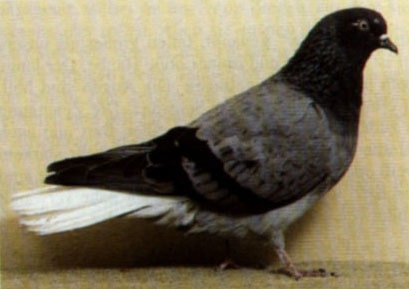
Oynak:Another old breed from this city (Konya). This breed has not been selected for a specific flight style. For this reason, it is possible to see any performance style in this breed high flying, tumbling, or rolling. This mid-size bird is similar to wild rock pigeon in looks. They are very faithful to their loft and almost impossible to get used to another. In Turkey they are used for speed homing races from 50 kilometers distance. They don't have any head ornaments but come in every color. They also exist in Germany. They fly for long time in high altitudes. Forked tail is not considered a fault.
Mardin Tumbler:During flight these birds clap their wings hard and create sounds and tumble in the meantime.
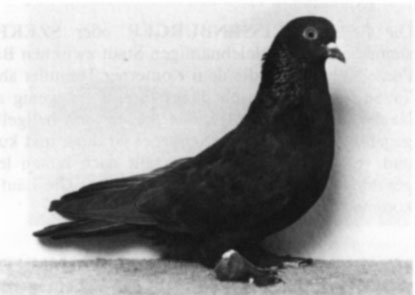
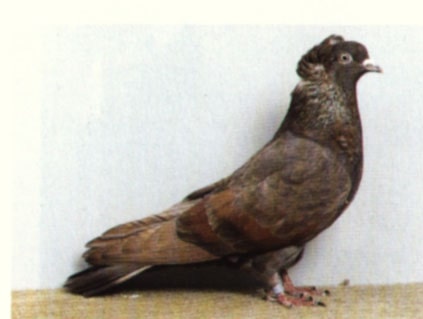
Anatolian Circle beater:This breed has come to Germany in 1981. Their origin is in the region of the city of Trabzon in Turkey. On the coast of Trabzon to inland to Kelkit, Erzincan and Erzurum. They are mainly raised in the livestock stall of the villages for many years. In the cities they are raised in the attics. City fanciers seem to have a better understanding of the breed. As they are called "crested wing clapper" in Turkish also raised based on this description. They are a field pigeon size and shape birds and carry a round crest in the back of the head. Their stance is mid-height and parallel to the ground. Head is longer and ends in a round curve with a round crest that extends to the neck and on each end has a visible rose twist. Eyes are yellow or light color and black in white birds. Birds from Trabzon and Kelkit mainly have yellow eyes and the ones from Erzincan light color eyes. Eye ring is not very obvious and blended into the bird's color. In the same way the beak also is colored similar to the bird's color. Neck is mid-length and chest is wide and full. Wings are mid-sized and carried on top of the tail. Outer flights can be worn out from clapping. Legs are mid-sized and clean legged. Feathers are tight and flexible, and the end in a wide shape. Colors in solids are black, white, red, yellow, rust, or black barred mouse gray, rust barred blue. Colors in pied are white flights and a white chest marking and the rest of the color solid. Markings in this breed are not important. What is important is that they show a lively character while clapping and turning. From pairings of white and other solid colors, similar to "spielderke" color, babies come out, without the white heart on the back. Breeding goal is to protect the clapping turning flight style while keeping the breed pure.
Kumru:Turkish version of the Arabic Trumpeter, that comes from central Anatolia. Black and white, small, and decorated birds. They are considered to be very aggressive and even when baby the breeders train them by sticking their hands into the nest. Besides this, they are fairly calm. Breeders take these birds in pairs to coffee shops. Here two hens and two cocks put on top of a table. Birds immediately go after each other and start fighting but without any wounds. The bird that gives up shows this by shaking its wings. Another version of the pigeon fight is a cardboard box being placed on top of a wood beam on the air that is supported by two chair backs, one on each end. As soon as the first pair put into the box, they claim it as their nest. After this the first pair is removed and the second pair put into same box for them to claim it also. When this happens the first pair is put back into the box next to the other. With this the fight starts. Because of this fighting orient there is only one pair of birds kept in each coop. These birds sit just like the Arabian Trumpeters, and it is said that you can hear even the babies in the nest singing.
Turkish Dewlap:They are similar to Syrian dewlaps as far as the body structure. However, compared to Syrian dewlaps they come in many more different colors. Especially self-colors like black, dark blue, blue check, ash red bar, smokey and indigo. Besides these, there are following color combinations: Main color being silver or gray silver, dark color wing and tail marking. Head color darker color than the rest of the body. Silver neck. These come in all dark or light colors. It is common to see birds in Turkey with white beard, white tail, white saddled or white barred black birds. These birds, even though are not different than the Syrian dewlaps as far as their body shape, are known as Lubenon (Lebanon) worldwide.
Adana or Ear-ringed Dewlap:They are from the city of Adana in Turkey and were brought to Germany by the Turkish workers in this country. Even though they are very similar to Beirut Dewlaps, they are smaller, lighter, and primarily used for the flight sport. When flown they gain altitude slowly in circles. They are capable of going as high as becoming dot in the sky but, this is not liked by the breeders. Since each bird reacts to the dropper from a certain height. Breeders use a flag to keep their birds flying. When a dropper is shown, they land with an extremely high-speed dive. Spiral dive lasts only a few seconds and ends with a spectacular sound while the birds break by opening their wings. This dive is an amazing show. These birds' upright dive and in the last moment how they stop without slamming into the earth every time puzzles the breeders and their flight skills and art is not possible to understand. They are very smart and respond to their breeders signals right away. These birds are dependent on their breeder’s individual attention. Turkish breeders spend all of their free time with their birds. Colors and markings are valued much but the birds flight and performance is the primary concern.
Turkish Pigeon:It is known as the father of all wattled breeds along with Persian Carrier. Spanish pigeon breed expert Brage says it is the oldest domesticated pigeon in the world and thinks it has originated in Middle East. Aldrovandi also mentions this bird in 1566. This bird has to be the first postal pigeon of the world. Attached to his home and anxious to fly. Of course, not as a long-distance flier. In later years these birds came to Europe and got mixed with other breeds. In Germany at first, they were raised as pure but, after a while they were mixed to get their beaks shorter


Turkish Baghdad:It is very common to run in to this breed even today. They can be seen in almost every pigeon market in Turkey. They are very similar to Syrian Baghdad. They are a preserved version of the original Baghdads
Anatolian Bango:This breed came to England about 200 years ago from Middle East, especially Anatolia, from there to Germany some years later. They are considered to be the father of all saddle marked turbits. They have a short but likeable structure. Head as possible as round, full, and fore headed, full cheeks and clean headed. Head is almost like part of the wide beak. Eyes are big and dark color, eye rim is light color, neck is short and stubby a little bent back. Chest wide and sticks out forward. Stomach has to be short and well developed. Short back with wider shoulders and leveled down to back. Short wings have to be very tightly closed. Legs short and clean. Only one marking is known, saddled with color tail. It is desired to have 8 to 10 flights white but possible to see colored flights also. Colors are black, gray, blue bar, blue check, silver blue, red, yellow, dominant red bar and brown. Red and yellow have been developed recently. In Anatolia, where it is still raised, there are other markings present. Such as white self, color tail, saddle but with white tail. Peak crest, tail carrying white in the middle or muffed versions of this breed exists in the east but are mixed breeds. In Germany self-whites and colored tails were acceptable until 30's.
Aydın Bango:This breed is very close to being extinct. They are originated from Aydın which is to south of Izmir. They were clean legged, clean headed or sometimes peak crested. Since the head was not completely round and the beak longer than most bangos, they lost their value in Europe quickly
Domino Bango:It is a different marking type of Aydın bango. These ones also came to Europe from Aydın and are known to be here since 1890. They have been mixed with other bangos to better them, especially with Anatolian bango. Domino is larger than the Anatolian, short and cute birds. Head must be round and draw a continuous line with the beak. Forehead is wide and full. Clean head or peak crested. Large eyes orange color and the rim is skin color. Short and thick beak is light color in red and yellow birds and dark color in all other colors. Neck is short, thick, and bent back a little. Chest is wide and sticks out with a clear line feather marking. Back is wide on the shoulder and levels down towards the rear. Wings are closed tight and carried above the tail. Short and nd of the neck and covers the crest. In the front the color ends at tip of the feather line. As much as possible 8 to 10 flights should be white. Colors are blue, black, red, yellow, blue bar, silver-blue, silver-red, and silver-yellow.
Oriental Bango or Izmir Bango:It is from Middle East. They are mostly imported from Izmir. They have been raised in Germany since about 1850. They were imported to England and Holland much earlier. They are small, short, and low pigeons. Head is fairly large and round, wide and full forehead, and full cheeked. Space between the eyes must reach the nose without interruption. Head is not circle or ellipse. It is with the forehead width present somewhere in between these two shapes. Because of this the highest point of the head is not above the eyes but in front of them. Eyes big and lively, orange in colored birds and dark in white birds. Side of the eyes low, strait, and pale, neck short and stocky expends out of the shoulders. Throat and chest rose has to be well developed. Chest is wide and carried high. Short wings are tightly stuck to body. Legs covered with feathers until the toes. Feathering on the side of the leg is longer but not a long muff. This breed’s coloring style is named in a different way.
